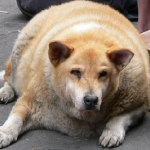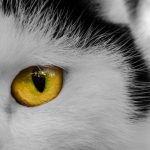What You Can’t See Won’t Hurt Your Pet?

When I was taking a class in Animal Iridology there was another student who was discussing her two cats. She was commenting on how her cats drank a tremendous amount of water—and, she did emphasize “a tremendous amount of water.”
I said, “Cats shouldn’t be drinking a lot of water because they’re supposed to get most of their hydration from their food. What are you feeding them?”
She said, “I feed them dry food.” And, then she giggled and added, “Yeah, I know, I’m supposed to feed them raw meat. But I’m too lazy.”
Now I expected to hear this from a novice, or from somebody who doesn’t know any better, but this woman was studying for her PhD in animal naturopathy. And, being a naturopath myself, I know that nutrition, and especially understanding the benefits behind a species appropriate diet, is a BIG DEAL in our training. So, needless to say I was a little taken aback by her comment.
I wanted to say to her, “What? you’re going for a PhD in animal naturopathy and you feed your cats a processed commercial kibble diet? Geez, what do you tell your clients about nutrition, duh?”
But, I didn’t. I didn’t want to be rude or start a fight.
Instead, I said: “A cat drinking a tremendous amount of water is an indication of dehydration. This could lead to kidney problems, and the high carbohydrate content (in kibbles) could cause UTI.” And, for for somebody who is studying for their PhD in animal naturopathy you should know this.
The woman answered: “Yeah, well, I’ve been feeding them that stuff for eight years, and I don’t see no (health) problem.”
Wow. At this point, I just backed off. I could’ve said more like “The cats drinking a lot of water IS a symptom of something wrong.” But, I don’t think this woman was open enough to listen. After all, she did say she was lazy.
Instead, I’ll tell you what I wanted to tell this woman because you’re reading this blog, and hopefully, you’re more willing to listen.
It’s amazing how resilient animals are. It can take years of eating a commercial processed diet before you begin to see signs of any health problems in your cat or dog. But the pancreas, liver, and the kidney, can only take so much abuse before these organs begin to break down. As a matter of fact, most cats or dogs don’t show any sign of kidney failure until after 70% to 75% of their kidney function has already been lost. That’s a lot of organ damage! So, while you think everything looks good on the outside, the inside is slowly deteriorating.
Dr. Kollath of the Karolinska Hospital in Stockholm, Sweden, headed the following study on animals: When young animals were fed cooked and processed food they initially appeared to be healthy. However, as the animals reached adulthood they began to age more quickly than normal and also developed chronic degenerative disease symptoms. A control group of animals raised on raw whole meat not only aged less quickly but were free of degenerative diseases.
It’s no coincidence that the number of cats with feline lower urinary tract disease (FLUTD) and renal failure has skyrocketed since the introduction of dry pet food. This is the worst possible diet for cats, but since it can take several years for FLUTD or full-blown kidney disease to develop, poor nutrition is rarely considered a contributing factor.
Meat-eating animals like cats and dogs are designed to have a slightly acidic urine with a PH balance between 6 and 6.5. But, when a carnivore is fed an unnatural diet of dry food/kibble, which is high in carbohydrates (or, canned food with grain contents), this causes their urine to become more alkaline and that can lead to three major health problems: Urinary Tract Infection (UTI), Cystitis (bladder inflammation), and Urinary Crystals and Stones.
So, a healthy Uric PH balance is important for your dog or cats bladder.
But, it doesn’t stop there. And, because cats and dogs are not designed to digest and/or process high loads of carbohydrates/starches it is also extremely taxing to the animal’s insulin levels, which in turn, is very taxing on the pancreas.
Also, these processed dry foods are completely devoid of natural digestive enzymes, such as, amylase, lipase, and protease (found abundantly in raw meat), which helps to reduce pancreatic stress, and this can cause the pancreas to be in a constant state of inflammation. Consuming processed food forces the pancreas to secrete its limited supply of digestive enzymes, and if the pancreas becomes over-taxed, the result is pancreatitis.
Recent research found that between 40% to 70% of cats that were autopsied had lesions of pancreatitis. And, those cats didn’t even die of a pancreatic problem—the cats died from another illness! But, it just goes to show how delicate and easily damaged the pancreas can become without first showing symptoms and/or secondary to other disease processes. Read the study HERE.
It doesn’t stop there. A recent study showed that 20% of dogs and 22% of cats between the age of 1 and 2 years old had radiographic signs of osteoarthritis. By the age of 12-years old, 90% of cats had radiographic evidence of osteoarthritis. But of that age group, only 16.5% had clinical signs of lameness. It just goes to show that cats are very good at hiding pain.
So, the old saying “what you can’t see won’t hurt you,” just isn’t true.










